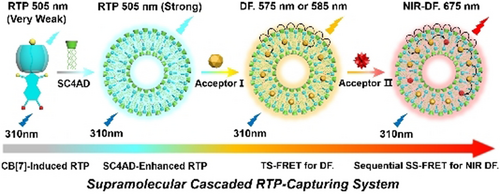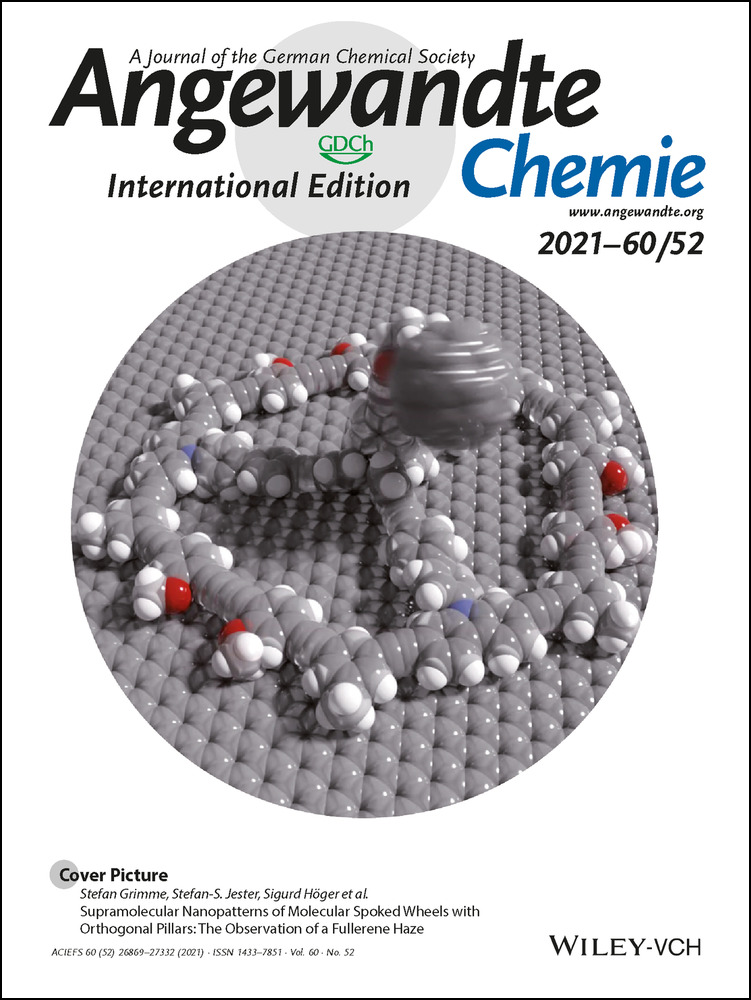Ultrahigh Supramolecular Cascaded Room-Temperature Phosphorescence Capturing System
Dr. Man Huo
College of Chemistry, State Key Laboratory of Elemento-Organic Chemistry, Nankai University, Tianjin, 300071 P. R. China
These authors contributed equally to this work.
Search for more papers by this authorXian-Yin Dai
College of Chemistry, State Key Laboratory of Elemento-Organic Chemistry, Nankai University, Tianjin, 300071 P. R. China
These authors contributed equally to this work.
Search for more papers by this authorCorresponding Author
Prof. Dr. Yu Liu
College of Chemistry, State Key Laboratory of Elemento-Organic Chemistry, Nankai University, Tianjin, 300071 P. R. China
Search for more papers by this authorDr. Man Huo
College of Chemistry, State Key Laboratory of Elemento-Organic Chemistry, Nankai University, Tianjin, 300071 P. R. China
These authors contributed equally to this work.
Search for more papers by this authorXian-Yin Dai
College of Chemistry, State Key Laboratory of Elemento-Organic Chemistry, Nankai University, Tianjin, 300071 P. R. China
These authors contributed equally to this work.
Search for more papers by this authorCorresponding Author
Prof. Dr. Yu Liu
College of Chemistry, State Key Laboratory of Elemento-Organic Chemistry, Nankai University, Tianjin, 300071 P. R. China
Search for more papers by this authorDedicated to the 100th anniversary of Chemistry at Nankai University
Graphical Abstract
An ultrahigh supramolecular cascaded RTP-capturing system was constructed based on a multivalent supramolecular aggregate using cucurbit[7]uril (CB[7]) and sulfonatocalix[4]arene (SC4AD) in aqueous medium. Energy transfer from G⊂CB[7]@SC4AD to primary (RhB or DBT) and then to secondary energy acceptors (Cy5 or NiB) gives rise to long-range and long-lived photoluminescence, especially NIR delayed emission (675 nm).
Abstract
An ultrahigh supramolecular cascaded phosphorescence-capturing aggregate was constructed by multivalent co-assembly of cucurbit[7]uril (CB[7]) and amphipathic sulfonatocalix[4]arene (SC4AD). The initial dibromophthalimide derivative (G) generated a weak phosphorescent emission at 505 nm by host–guest interaction with CB[7], which further assembled with SC4AD to form homogeneously spherical nanoparticles with a dramatic enhancement of both phosphorescence lifetime to 1.13 ms and emission intensity by 40-fold. Notably, this G⊂CB[7]@SC4AD aggregate exhibited efficient phosphorescence energy transfer to Rhodamine B (RhB) and benzothiadiazole (DBT) with high efficiency (ϕET) of 84.4 % and 76.3 % and an antenna effect (AE) of 289.4 and 119.5, respectively, and then each of these can function as a bridge to further transfer their energy to second near-IR acceptors Cy5 or Nile blue (NiB) to achieve cascaded phosphorescence energy transfer. The final aggregate with long-range effect from 425 nm to 800 nm and long-lived photoluminescence was further employed as an imaging agent for multicolour cell labeling.
Conflict of interest
The authors declare no conflict of interest.
Supporting Information
As a service to our authors and readers, this journal provides supporting information supplied by the authors. Such materials are peer reviewed and may be re-organized for online delivery, but are not copy-edited or typeset. Technical support issues arising from supporting information (other than missing files) should be addressed to the authors.
| Filename | Description |
|---|---|
| anie202113577-sup-0001-misc_information.pdf4.5 MB | Supporting Information |
Please note: The publisher is not responsible for the content or functionality of any supporting information supplied by the authors. Any queries (other than missing content) should be directed to the corresponding author for the article.
References
- 1
- 1aY. Yu, M. S. Kwon, J. Jung, Y. Zeng, M. Kim, K. Chung, J. Gierschner, J. H. Youk, S. M. Borisov, J. Kim, Angew. Chem. Int. Ed. 2017, 56, 16207–16211; Angew. Chem. 2017, 129, 16425–16429;
- 1bG. Zhang, G. M. Palmer, M. W. Dewhirst, C. L. Fraser, Nat. Mater. 2009, 8, 747–751;
- 1cS. Kuila, K. V. Rao, S. Garain, P. K. Samanta, S. Das, S. K. Pati, M. Eswaramoorthy, S. J. George, Angew. Chem. Int. Ed. 2018, 57, 17115–17119; Angew. Chem. 2018, 130, 17361–17365.
- 2C. Adachi, M. A. Baldo, M. E. Thompson, S. R. Forrest, J. Appl. Phys. 2001, 90, 5048–5051.
- 3
- 3aK. Jiang, L. Zhang, J. Lu, C. Xu, C. Cai, H. Lin, Angew. Chem. Int. Ed. 2016, 55, 7231–7235; Angew. Chem. 2016, 128, 7347–7351;
- 3bS. Cai, H. Shi, D. Tian, H. Ma, Z. Cheng, Q. Wu, M. Gu, L. Huang, Z. An, Q. Peng, W. Huang, Adv. Funct. Mater. 2018, 28, 1705045;
- 3cX. Yao, J. Wang, D. Jiao, Z. Huang, O. Mhirsi, F. Lossada, L. Chen, B. Haehnle, A. J. C. Kuehne, X. Ma, H. Tian, A. Walther, Adv. Mater. 2021, 33, e2005973;
- 3dL. Bian, H. Shi, X. Wang, K. Ling, H. Ma, M. Li, Z. Cheng, C. Ma, S. Cai, Q. Wu, N. Gan, X. Xu, Z. An, W. Huang, J. Am. Chem. Soc. 2018, 140, 10734–10739.
- 4
- 4aJ. Yang, M. Fang, Z. Li, Acc. Mater. Res. 2021, 2, 644–654;
- 4bS. Zhang, M. Hosaka, T. Yoshihara, K. Negishi, Y. Iida, S. Tobita, T. Takeuchi, Cancer Res. 2010, 70, 4490–4498;
- 4cX. F. Wang, H. Xiao, P. Z. Chen, Q. Z. Yang, B. Chen, C. H. Tung, Y. Z. Chen, L. Z. Wu, J. Am. Chem. Soc. 2019, 141, 5045–5050.
- 5
- 5aY. Wang, H. Gao, J. Yang, M. Fang, D. Ding, B. Z. Tang, Z. Li, Adv. Mater. 2021, 33, e2007811;
- 5bJ. Yang, Y. Zhang, X. Wu, W. Dai, D. Chen, J. Shi, B. Tong, Q. Peng, H. Xie, Z. Cai, Y. Dong, X. Zhang, Nat. Commun. 2021, 12, 4883.
- 6
- 6aT. Zhang, X. Ma, H. Wu, L. Zhu, Y. Zhao, H. Tian, Angew. Chem. Int. Ed. 2020, 59, 11206–11216; Angew. Chem. 2020, 132, 11302–11312;
- 6bH. Zhu, I. Badia-Dominguez, B. Shi, Q. Li, P. Wei, H. Xing, M. C. Ruiz Delgado, F. Huang, J. Am. Chem. Soc. 2021, 143, 2164–2169.
- 7
- 7aY. Gong, G. Chen, Q. Peng, W. Z. Yuan, Y. Xie, S. Li, Y. Zhang, B. Z. Tang, Adv. Mater. 2015, 27, 6195–6201;
- 7bJ. Yang, X. Zhen, B. Wang, X. Gao, Z. Ren, J. Wang, Y. Xie, J. Li, Q. Peng, K. Pu, Z. Li, Nat. Commun. 2018, 9, 840;
- 7cB. Zhou, G. Xiao, D. Yan, Adv. Mater. 2021, 33, e200757.
- 8
- 8aL. Gu, H. Wu, H. Ma, W. Ye, W. Jia, H. Wang, H. Chen, N. Zhang, D. Wang, C. Qian, Z. An, W. Huang, Y. Zhao, Nat. Commun. 2020, 11, 944;
- 8bY. Su, Y. Zhang, Z. Wang, W. Gao, P. Jia, D. Zhang, C. Yang, Y. Li, Y. Zhao, Angew. Chem. Int. Ed. 2020, 59, 9967–9971; Angew. Chem. 2020, 132, 10053–10057;
- 8cZ. Y. Zhang, W. W. Xu, W. S. Xu, J. Niu, X. H. Sun, Y. Liu, Angew. Chem. Int. Ed. 2020, 59, 18748–18754; Angew. Chem. 2020, 132, 18907–18913.
- 9
- 9aD. Lee, O. Bolton, B. C. Kim, J. H. Youk, S. Takayama, J. Kim, J. Am. Chem. Soc. 2013, 135, 6325–6329;
- 9bZ. Lin, R. Kabe, N. Nishimura, K. Jinnai, C. Adachi, Adv. Mater. 2018, 30, e1803713.
- 10
- 10aS. Xu, W. Wang, H. Li, J. Zhang, R. Chen, S. Wang, C. Zheng, G. Xing, C. Song, W. Huang, Nat. Commun. 2020, 11, 4802;
- 10bZ. A. Yan, X. Lin, S. Sun, X. Ma, H. Tian, Angew. Chem. Int. Ed. 2021, 60, 19735–19739; Angew. Chem. 2021, 133, 19887–19891;
- 10cY. Zhang, Y. Su, H. Wu, Z. Wang, C. Wang, Y. Zheng, X. Zheng, L. Gao, Q. Zhou, Y. Yang, X. Chen, C. Yang, Y. Zhao, J. Am. Chem. Soc. 2021, 143, 13675–13685.
- 11
- 11aW. L. Zhou, Y. Chen, Q. Yu, H. Zhang, Z. X. Liu, X. Y. Dai, J. J. Li, Y. Liu, Nat. Commun. Nat. Commun 2020, 11, 4655;
- 11bY. Lei, W. Dai, J. Guan, S. Guo, F. Ren, Y. Zhou, J. Shi, B. Tong, Z. Cai, J. Zheng, Y. Dong, Angew. Chem. Int. Ed. 2020, 59, 16054–16060; Angew. Chem. 2020, 132, 16188–16194;
- 11cP. Wei, X. Zhang, J. Liu, G. G. Shan, H. Zhang, J. Qi, W. Zhao, H. H. Sung, I. D. Williams, J. W. Y. Lam, B. Z. Tang, Angew. Chem. Int. Ed. 2020, 59, 9293–9298; Angew. Chem. 2020, 132, 9379–9384;
- 11dX. Yu, W. Liang, Q. Huang, W. Wu, J. J. Chruma, C. Yang, Chem. Commun. 2019, 55, 3156–3159.
- 12D. Li, F. Lu, J. Wang, W. Hu, X. M. Cao, X. Ma, H. Tian, J. Am. Chem. Soc. 2018, 140, 1916–1923.
- 13
- 13aX. K. Ma, W. Zhang, Z. Liu, H. Zhang, B. Zhang, Y. Liu, Adv. Mater. 2021, 33, e2007476;
- 13bZ.-Y. Zhang, Y. Chen, Y. Liu, Angew. Chem. Int. Ed. 2019, 58, 6028–6032; Angew. Chem. 2019, 131, 6089–6093.
- 14
- 14aX. Ma, J. Wang, H. Tian, Acc. Chem. Res. 2019, 52, 738–748;
- 14bJ. Wang, Z. Huang, X. Ma, H. Tian, Angew. Chem. Int. Ed. 2020, 59, 9928–9933; Angew. Chem. 2020, 132, 10014–10019.
- 15
- 15aZ. Xu, S. Peng, Y. Y. Wang, J. K. Zhang, A. I. Lazar, D. S. Guo, Adv. Mater. 2016, 28, 7666–7671;
- 15bX. Zhu, J.-X. Wang, L.-Y. Niu, Q.-Z. Yang, Chem. Mater. 2019, 31, 3573–3581;
- 15cH. Q. Peng, L. Y. Niu, Y. Z. Chen, L. Z. Wu, C. H. Tung, Q. Z. Yang, Chem. Rev. 2015, 115, 7502–7542.
- 16
- 16aM. Hao, G. Sun, M. Zuo, Z. Xu, Y. Chen, X. Y. Hu, L. Wang, Angew. Chem. Int. Ed. 2020, 59, 10095–10100; Angew. Chem. 2020, 132, 10181–10186;
- 16bW. J. Li, X. Q. Wang, D. Y. Zhang, Y. X. Hu, W. T. Xu, L. Xu, W. Wang, H. B. Yang, Angew. Chem. Int. Ed. 2021, 60, 18761–18768; Angew. Chem. 2021, 133, 18909–18916.
- 17G. Sun, W. Qian, J. Jiao, T. Han, Y. Shi, X.-Y. Hu, L. Wang, J. Mater. Chem. A 2020, 8, 9590–9596.
- 18Z. Xu, D. Gonzalez-Abradelo, J. Li, C. A. Strassert, B. J. Ravoo, D.-S. Guo, Mater. Chem. Front. 2017, 1, 1847–1852.
- 19J. J. Li, Y. Chen, J. Yu, N. Cheng, Y. Liu, Adv. Mater. 2017, 29, 1701905.
- 20
- 20aS. Kuila, S. J. George, Angew. Chem. Int. Ed. 2020, 59, 9393–9397; Angew. Chem. 2020, 132, 9479–9483;
- 20bH. Gui, Z. Huang, Z. Yuan, X. Ma, CCS Chem. 2021, 3, 481–489;
- 20cC. Fan, L. Wei, T. Niu, M. Rao, G. Cheng, J. J. Chruma, W. Wu, C. Yang, J. Am. Chem. Soc. 2019, 141, 15070;
- 20dA. Kirch, M. Gmelch, S. Reineke, J. Phys. Chem. Lett. 2019, 10, 310–315.
- 21
- 21aR. Gao, D. Yan, Chem. Sci. 2017, 8, 590–599;
- 21bZ. Li, Y. Han, F. Wang, Nat. Commun. 2019, 10, 3735.
- 22S. Garain, B. C. Garain, M. Eswaramoorthy, S. K. Pati, S. J. George, Angew. Chem. Int. Ed. 2021, 60, 19720–19724; Angew. Chem. 2021, 133, 19872–19876.
- 23S. Garain, S. Kuila, B. C. Garain, M. Kataria, A. Borah, S. K. Pati, S. J. George, Angew. Chem. Int. Ed. 2021, 60, 12323–12327; Angew. Chem. 2021, 133, 12431–12435.
- 24S. J. Barrow, S. Kasera, M. J. Rowland, J. del Barrio, O. A. Scherman, Chem. Rev. 2015, 115, 12320–12406.
- 25
- 25aP. Li, Y. Chen, Y. Liu, Chin. Chem. Lett. 2019, 30, 1190–1197;
- 25bY. C. Pan, X. Y. Hu, D. S. Guo, Angew. Chem. Int. Ed. 2021, 60, 2768–2794; Angew. Chem. 2021, 133, 2800–2828.





